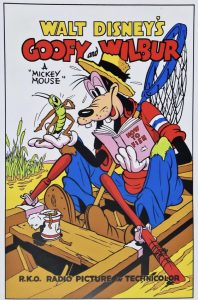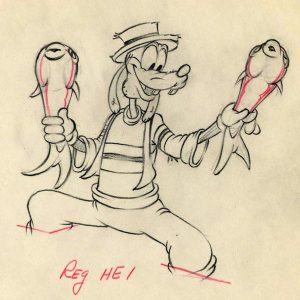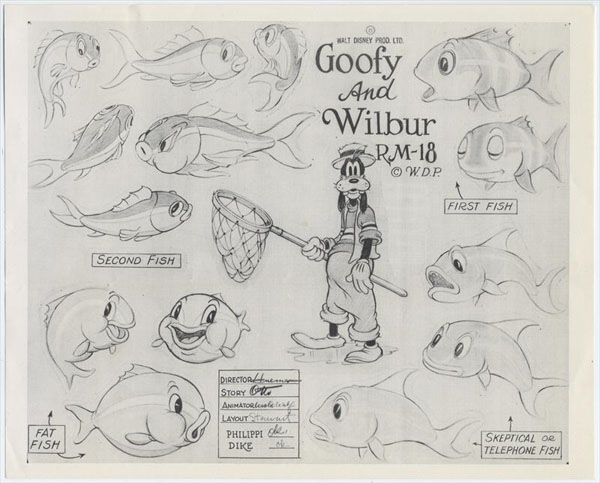 It was 1939, and what a year for film. In addition to Gone With the Wind, The Wizard of Oz, Mr. Smith Goes to Washington, and many of the other now illustrious movies that bowed that year, another significant debut happened.
It was 1939, and what a year for film. In addition to Gone With the Wind, The Wizard of Oz, Mr. Smith Goes to Washington, and many of the other now illustrious movies that bowed that year, another significant debut happened.
The first starring role of Goofy.
After seven years in supporting roles, it was time for this significant Disney player to take center stage in the short Goofy and Wilbur. Making his debut as Dippy Dawg in Mickey’s Revue (1932), Goofy was a hit with audiences, appearing in a number of short subjects with Mickey, Donald, and the gang, such as the popular The Band Concert (1935) and Lonesome Ghosts (1937), before branching out on his own for Goofy and Wilbur.
The debut short was directed by the legendary Dick Huemer, who started his career at Disney in 1933, as an animator, after working for a decade with the Fleischer Studio. The same year that Goofy and Wilbur debuted, Huemer also directed the Mickey Mouse short, The Whalers.
Later at Disney, Huemer would partner with fellow legend Joe Grant, where they served as story directors for Fantasia (1940) and wrote the screenplay for Dumbo (1941).
 In Goofy and Wilbur, marking its 85th anniversary this year, Huemer, as director, not only gives Goofy (voiced here by actor Jack Bailey) center stage but introduces a new character, Wilbur, Goofy’s pet grasshopper. As the short opens, and we meet them both, they’re going on a fishing trip (stopping their boat in a “no fishing area” of a lake).
In Goofy and Wilbur, marking its 85th anniversary this year, Huemer, as director, not only gives Goofy (voiced here by actor Jack Bailey) center stage but introduces a new character, Wilbur, Goofy’s pet grasshopper. As the short opens, and we meet them both, they’re going on a fishing trip (stopping their boat in a “no fishing area” of a lake).
However, this isn’t just two buddies out for the day; Wilbur is happily used as bait. Forgoing the usual route of a fishing pole, Wilbur skitters across the water, and Goofy rings a horseshoe like a dinner bell.
As the fish jump out of the water after Wilbur, Goofy extends a net to snag the fish. All is going well until Wilbur is swallowed by a fish (in a nice gag, Goofy uses the fish like a phone to try and talk with Wilbur).
Wilbur is saved from the fish but is later swallowed by a frog, which in turn is swallowed by a stork. Goofy tries to chase the stork and rescue Wilbur in another clever moment where Goofy and the stork run the same way.
When he can’t catch the stork and his best friend seems lost, Goofy is despondent (even imagining a vision of Wilbur as an angel playing the harp) until an egg in the stork nest hatches and low-and-behold Wilbur pops out of it, reuniting the two for a happy ending.
A number of other Disney animation legends worked on Goofy and Wilbur, including Art Babbitt, Ed Love, and Wolfgang Reitherman. Their talents can be seen in the smooth and kinetic sequences and physical humor. Of note is one scene where two fish attempt to eat Wilbur, and one winds up swallowing the other, and another where Goofy darts out of the boat and begins running on water.

What’s interesting about Goofy and Wilbur is that although the short is Goofy’s solo debut, much of the run-time focuses on Wilbur, who has a genial design and is involved in inventive sequences outsmarting the fish. At the time of the short’s release, The Film Daily noted, “The characterization of Wilbur is so real that one seems to have known him a long time. All Disney followers will welcome him.”
However, Goofy and Wilbur seems to be Wilbur’s only screen appearance. In 1956, Goofy and Wilbur was shown with other Disney shorts as part of “On Vacation with Mickey Mouse and Friends,” an episode of Disney’s weekly anthology show. In the episode, Wilbur is referred to as the nephew of the episode’s host, Jiminy Cricket (in a bit of Disney “retcon”).
Still, 85 years later, Goofy & Wilbur is significant because it made a leading man out of one of Disney’s biggest and still most iconic stars. The short demonstrates how well the Disney animators understood Goofy and why audiences still respond to his personality.
Art Babbit best sums up the character’s persona in his 1934 studio notes, “Analysis of the Goof,” where he writes of Goofy: “He has music in his heart even though it may be the same tune forever, and I see him humming it to himself while working or thinking. He talks to himself because it is easier for him to know what he is thinking if he hears it first.”


 Michael Lyons is a freelance writer, specializing in film, television, and pop culture. He is the author of the book, Drawn to Greatness: Disney’s Animation Renaissance, which chronicles the amazing growth at the Disney animation studio in the 1990s. In addition to Animation Scoop and Cartoon Research, he has contributed to Remind Magazine, Cinefantastique, Animation World Network and Disney Magazine. He also writes a blog, Screen Saver: A Retro Review of TV Shows and Movies of Yesteryear and his interviews with a number of animation legends have been featured in several volumes of the books, Walt’s People. You can visit Michael’s web site Words From Lyons at:
Michael Lyons is a freelance writer, specializing in film, television, and pop culture. He is the author of the book, Drawn to Greatness: Disney’s Animation Renaissance, which chronicles the amazing growth at the Disney animation studio in the 1990s. In addition to Animation Scoop and Cartoon Research, he has contributed to Remind Magazine, Cinefantastique, Animation World Network and Disney Magazine. He also writes a blog, Screen Saver: A Retro Review of TV Shows and Movies of Yesteryear and his interviews with a number of animation legends have been featured in several volumes of the books, Walt’s People. You can visit Michael’s web site Words From Lyons at: 






















Unlike his conspecific in the 1934 Silly Symphony, Wilbur doesn’t seem to mind putting in an honest day’s work, and for no apparent gain. The other grasshoppers probably think he’s a perfect chump for continually risking his life on Goofy’s behalf. What’s in it for him?
In 1939 Pinto Colvig was in Miami working for Max Fleischer. I think I like Jack Bailey’s Goofy better than I do Colvig’s Bluto.
I wonder if the violinist who did Wilbur’s sound effects also provided those of the princess in “Music Land”.
All in all, “Goofy and Wilbur” is a fun cartoon, but I could do without all the spitting.
When Goofy’s hands are shown in close-up, he has an extra finger. It’s odd , with all the care that they put into these films, that nobody caught that.
It’s in all the extreme closeups so it’s obviously intentional. And it’s not a unique practice. For example, Bugs has five fingers in “Rhapsody Rabbit” closeups of his hands on the keyboard.
Art Babbitt typically drew Goofy with five fingers even in regular shots, which apparently really irked Jack Kinney. You can see five-fingered Goofs in the later shorts Goofy’s Glider and especially Baggage Buster, which was almost entirely animated by Babbitt using live action reference. As Kinney felt at the time, it looks stiff and inappropriate for Goofy.
Bugs having five fingers in the close up shots in Rhapsody Rabbit is likely also a consequence of using live action reference to make the piano playing animation convincing. He’s also drawn with five fingers in a similar close up shot in Rabbit of Seville where his fingers tap on Elmer’s head in time with the music.
The Close-Ups on Goofy’s hands are most likely based on Dick Huemer’s drawings. You can spot them in his work on the Mutt and Jeff and Out of the Inkwell cartoons.
I can’t make out the storyman and animator’s names on the model sheet; I can only see Huemer’s and layout man MacLaren Stewart. I think “Clock Cleaners” is my favorite Goofy ensemble appearance, and “Hockey Homicide” my favorite solo, but he makes a great solo debut here.
Is this the same Jack Bailey who hosted “Queen For A Day” in the 1950s on TV? Mr. Bailey also hosted some radio programs as well. Just Curious.
One and the same, as per his Wikipedia article: https://en.wikipedia.org/wiki/Goofy_and_Wilbur
I was lucky enough to see Goofy And Wilbur in a movie theatre –
Followed by The Pointer (1939) and Autograph Hound (1939) (all unabridged) in a Disney package called “Cartoon-A-Roonies” with introductory narration by Gary Owens.
It was a support to “Escape To Witch Mountain (1975).
At each matinee I attended, the full house responded enthusiastically, and both applauded and cheered loudly at the end of each cartoon